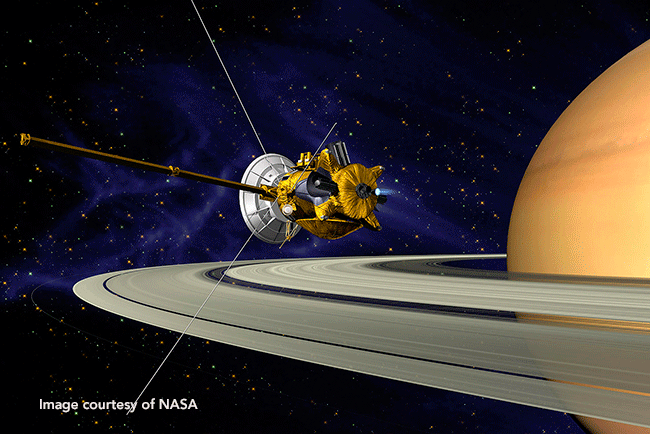Farewell Cassini farewell....

After clocking up nearly 13 years orbiting Saturn, on 15 September the international spacecraft Cassini–Huygens plunged into Saturn’s atmosphere and broke up, marking the end of this exploration around the solar system’s sixth biggest planet, known to one and all for its spectacular ring system, visible from Earth.
Over these years the spacecraft has carried out a series of intrepid exploration journeys between the planet and its rings before diving into Saturn’s atmosphere, where Cassini released the Huygens probe to land on the planet’s Titan moon.
The Cassini-Huygens spacecraft was launched back in 1997. After leaving the Earth it spent seven years travelling through the solar system until reaching Saturn. Some months later the mothership Cassini (US contribution) released the Huygens probe (European contribution), which then landed on the mysterious Titan, one of Saturn’s moons, thus becoming the first probe to land on a body in the outer solar system.
To get to Saturn the rocket performed several gravitational sling-shot maneuvers: two round Venus, one round the Earth, one round Jupiter and the last round Saturn’s most distant moon, Phoebe. Seven years later, after visiting seven Saturn moons, like Phoebe and Enceladus, and performing over 44 Titan flybys, Huygens separated from its Cassini mothership. In the 292 completed orbits round the planet the mission collected detailed information on its magnetic field and rings, among other features, discovering hitherto unknown worlds in Titan and the gas giant’s icy moons.
In recent months Cassini has been diving through the approximately 1200-mile-wide gap between Saturn and its rings. This ‘Grand Finale’ maximizes the mission’s scientific return, as it skirts the inner and outer edges of the rings and the planet’s small moons and skims the outer edges of Saturn’s atmosphere.
Cassini-Huygens is a joint endeavor of NASA, ESA and the Italian Space Agency, plus other European academic and industrial collaborators. The spacecraft was built with the participation of 19 countries.
GMV has played a key role in this mission performing all the following: supporting definition of the JPL/ESOC data interface; developing the operational software tool for fine calculation of Huygens data-transmission antenna pointing; conducting various studies and analyses of different entry and descent scenarios plus mission analysis studies in support of the redesign of the Huygens-Cassini communication link; and carrying out the analysis of link budget statistics in entry, descent and surface phases plus analysis of the best antenna pointing to ensure establishment of a good link between Huygens and Cassini.
This end of mission brings to a close twenty years of Saturn study by hundreds of scientists from 17 countries belonging to two different generations. But its legacy lives on. Other missions are now underway to study the solar system’s gas giant.